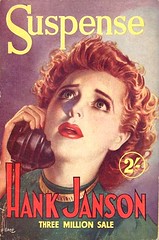This is very related to yesterday’s point on getting information in there while keeping the tension. Sometimes the dialogue that’s used to convey that information is losing readers and we can’t find any secret agent monkeys or secret bad guys to help out. (And sometimes the dialogue is just dull. Fix that first, and then see if the scene needs more tension.) Now what?
I’ll turn the time over to two of the books I’ve been reading for this series: Don’t Murder Your Mystery by Chris Roerden and Revision And Self-Editing by James Scott Bell.
 Bell can start us off with a point we’ve touched on: “Your Lead should be dealing with change, threat, or challenge from the get-go. At the very least, whenever she is in dialogue with another character, that inner tension is present” (97). Bringing out the inner conflicts can add subtext to even the dullest small talk. (But please, make sure that the small talk isn’t so small that it can’t support subtext
Bell can start us off with a point we’ve touched on: “Your Lead should be dealing with change, threat, or challenge from the get-go. At the very least, whenever she is in dialogue with another character, that inner tension is present” (97). Bringing out the inner conflicts can add subtext to even the dullest small talk. (But please, make sure that the small talk isn’t so small that it can’t support subtext  .)
.)
Roerden adds several techniques specifically for increasing tension in dialogue, since mysteries may require a lot of talky investigation. (And really, how many people would poison a PI’s potato chips?) She mentions bypass dialogue, borrowed conflict, simulated disagreement and flat-out editing (179-184).
Bypass dialogue is when two characters speak but don’t communicate. Naturally, this can be boring, but it can also be used to increase tension: make sure that the speakers have opposing agendas and different priorities, even if they’re friends. (“Transforming allies into temporary adversaries not only increases tension but also builds the reader’s empathy with your protagonist . . .” [180]).
You can also borrow conflict from a background source (a bit like yesterday’s fix). Roerden uses an example from a novel, a reporter interviewing a couple with a tennis game on TV in the background. When she asks about the victim, the husband suddenly swears. The reporter thinks she’s onto something—but he’s just upset about the game.
 Simulated disagreement is a bit more tricky—obviously, the name refers to when two characters seem to disagree without actually doing so. In the example Roerden cites, two female characters are trying to relate a creepy occurrence (which we’ve already seen dramatized) to a male third character. He has no real reason to disbelieve or oppose them, but he repeatedly interrupts them (increasing the tension) with stories of his own. One of the women (his wife), gets on his case for interrupting, further heightening the tension.
Simulated disagreement is a bit more tricky—obviously, the name refers to when two characters seem to disagree without actually doing so. In the example Roerden cites, two female characters are trying to relate a creepy occurrence (which we’ve already seen dramatized) to a male third character. He has no real reason to disbelieve or oppose them, but he repeatedly interrupts them (increasing the tension) with stories of his own. One of the women (his wife), gets on his case for interrupting, further heightening the tension.
Finally, flat-out editing can help—especially for phone calls. (Eesh. I hate those!) Roerden uses the example of a phone call from a novel where the protagonist is in her car, realizing she needs to get a clue from her husband. She’s already thought about the context—when they heard it, what bit of information it is exactly—so why show that in a phone conversation? Indeed, after the words “she called him,” the author skips right to the husband’s answer: “‘Yeah, I’ve got it right here. . . ‘”
CLOSING CAUTION: Overusing any technique or tension fix can be gimmicky or hackneyed—and can actually undercut the tension. Mix up your tension techniques to keep your readers reading without getting bored.
What do you think? Any good examples of the above fixes? Any other tension fixes? (Next week, we’ll look at suspense fixes, so let me know if there’s another tension fix you’ve used successfully—and if you’d like to guest post about it, just let me know!)
Photo credits: fraying rope—Govind Chakravarti; acorn hanging by a thread—Karen Dorsett
 looking at my own work.
looking at my own work.




 But then again, you might. Just as tension springs from conflict, suspense is created by anticipation. So the same things that fix scene tension might not fix story suspense.
But then again, you might. Just as tension springs from conflict, suspense is created by anticipation. So the same things that fix scene tension might not fix story suspense. ). Only you can tell what’s right for your story (and even then,
). Only you can tell what’s right for your story (and even then, 
 .)
.)


